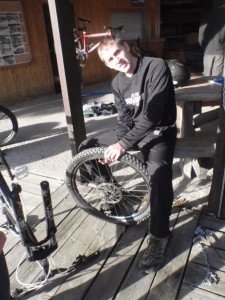When part of your Outdoor Adventure college course says you have to do cross-country cycling next week, what do you think of? I think of something like the Tour de France. I was proven seriously wrong a few weeks ago when I had this very course. Sure, we got there and had to sit for an hour learning parts and different types of bikes, but once we got outside and sized up our bikes we had a killer time.
 First we had to size up the bike. To tell if your bike is the right size for you, mount the bike and stand over the cross-bar of your bike facing forward with your butt right in front of the seat. With your legs straight, put your hand in a fist and stick it under your groin between the bar and your body. If the bike is the right height, your fist should have slight clearance (5 mm) on each side. To test your seat height, place one foot on the pedal in the lower position. The seat is set correct if you only have a slight bend in your knee. Test the brakes and handle bars for smooth movement and make sure the tires are very firmly inflated. For safety gear, helmets are required, especially if you are heading off-road like we were.
First we had to size up the bike. To tell if your bike is the right size for you, mount the bike and stand over the cross-bar of your bike facing forward with your butt right in front of the seat. With your legs straight, put your hand in a fist and stick it under your groin between the bar and your body. If the bike is the right height, your fist should have slight clearance (5 mm) on each side. To test your seat height, place one foot on the pedal in the lower position. The seat is set correct if you only have a slight bend in your knee. Test the brakes and handle bars for smooth movement and make sure the tires are very firmly inflated. For safety gear, helmets are required, especially if you are heading off-road like we were.
 In our cross-country cycling course we learned everything from wheelies to endos (opposite of a wheelie) to hops to jumps. Man this class was the bomb! We were riding Norco Bigfoots mostly and these bikes can take a serious beating. In the afternoon we took these bikes apart and learned the basics of repair.
In our cross-country cycling course we learned everything from wheelies to endos (opposite of a wheelie) to hops to jumps. Man this class was the bomb! We were riding Norco Bigfoots mostly and these bikes can take a serious beating. In the afternoon we took these bikes apart and learned the basics of repair.
 The second day of this class we did a 40 km ride around our training facility, Wilderness Tours. We did half of this on the road and the other half on trails. If you ever have a chance to run single track biking, take it without a second thought. Single tracks are trails in the forest for bikes. They could have jumps, turns, hills, etc. and really test the mettle of the bike and the cyclist. What a blast!
The second day of this class we did a 40 km ride around our training facility, Wilderness Tours. We did half of this on the road and the other half on trails. If you ever have a chance to run single track biking, take it without a second thought. Single tracks are trails in the forest for bikes. They could have jumps, turns, hills, etc. and really test the mettle of the bike and the cyclist. What a blast!
So far biking is my favourite of the fall activities.
Tags: cross-country, cycling, endo, hops, Norco Bigfoot, Outdoor Adventure, wheelie, Wilderness Tours